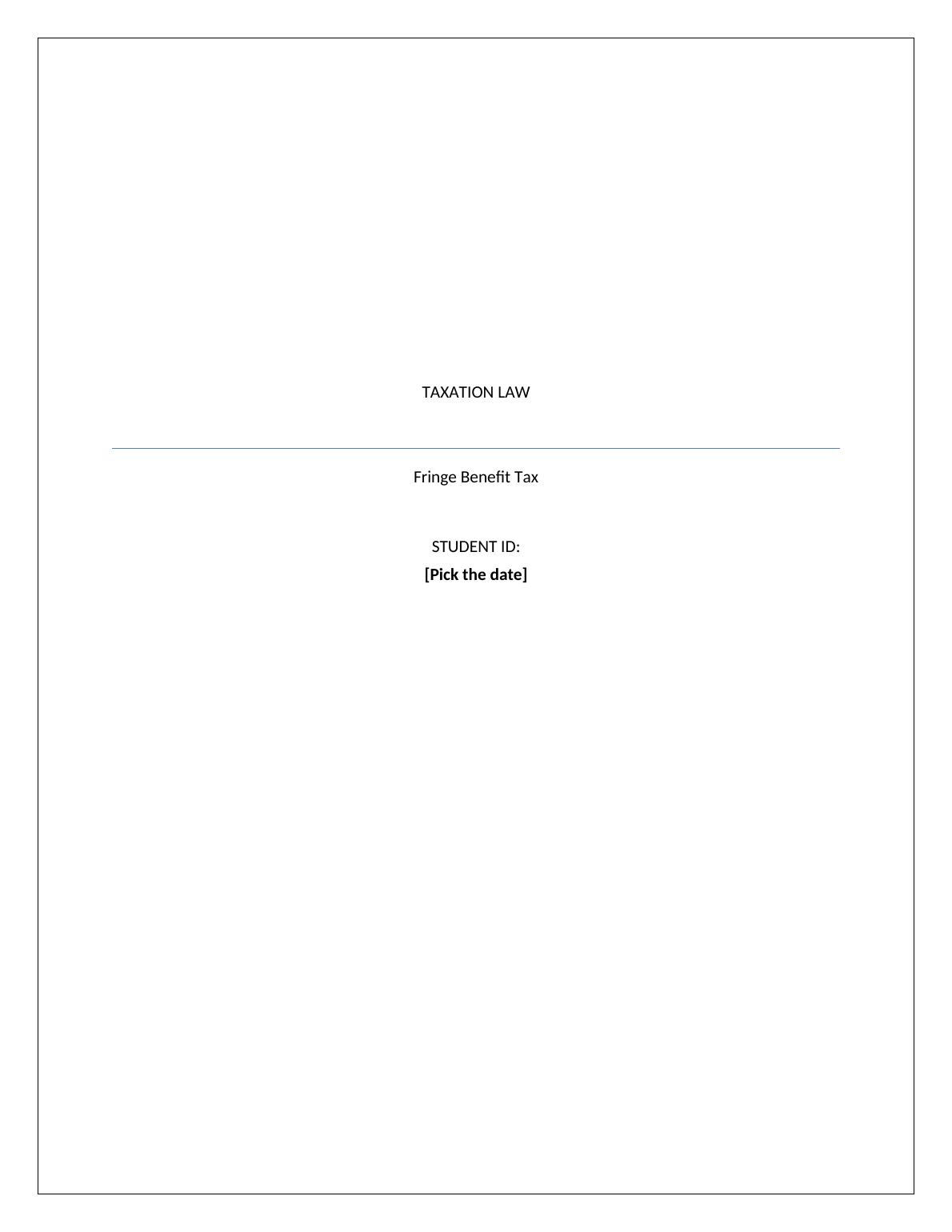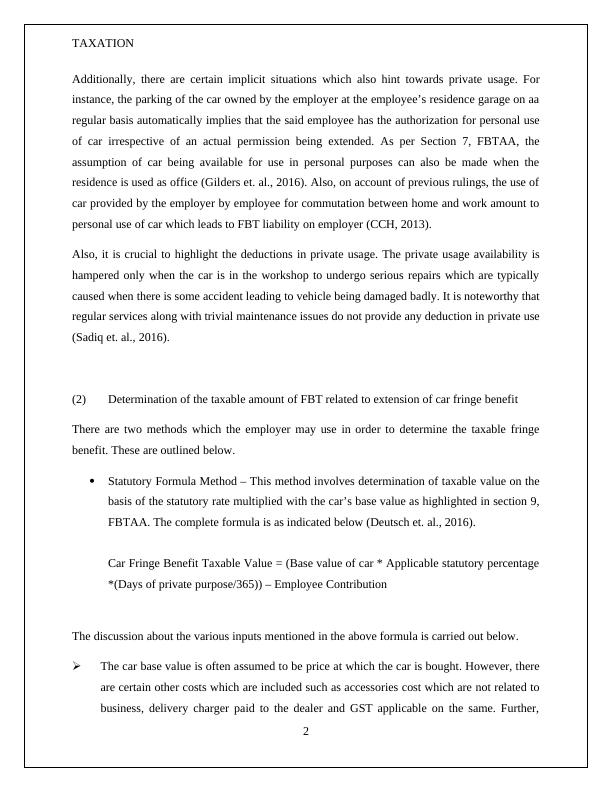Fringe Benefits Tax Assessment Act 1986 Taxation Law Assignment
9 Pages2523 Words36 Views
Added on 2020-04-07
Fringe Benefits Tax Assessment Act 1986 Taxation Law Assignment
Added on 2020-04-07
ShareRelated Documents
TAXATION LAW
Fringe Benefit Tax
STUDENT ID:
[Pick the date]
Fringe Benefit Tax
STUDENT ID:
[Pick the date]

TAXATION
Issue
The central issue in the present case is to offer an advice to employee Charlie and employer
Shine Homes Pty Ltd (Shiny Homes) for the fringe benefits consequences for the given events
for the income year 2017.
Law
Fringe benefits are the non- cashable benefits (for personal use) which are extended on the part
of the employer to their employee during their employment with the company. These types of
benefits result fringe benefit tax liability on the employer. The various fringe benefits are
highlighted in the Fringe Benefits Tax Assessment Act 1986 (Cth) “FBTAA86.” The various
relevant fringe benefits and their respective FBT computation is discussed below.
Car Fringe Benefit
When an employer has provided car to the employee for his/her own personal usage, then it is
termed as car fringe benefit. Tax Ruling TR 96/26 indicates the various aspects related to the Car
Fringe Benefit and the computation of the Fringe Benefit Tax (FBT) liability on the part of
employer (CCH, 2013). The necessary steps related to the computation of fringe benefit tax
liability are highlighted below.
(1) Total duration of utilization of private use of car in the assessment year
It is essential to find the actual date on which the car is available for the personal usage of
employee. According to section 7 of FBTAA86, the private usage of car is assumed in any of
the following two circumstances (Woellner, 2014).
Actual car use for personal work by the employee
The date on which the car has been offered to employee for personal utilization. In this case,
the date on which car is offered would be taken into consideration irrespective of the fact that
whether the employee has started using car for personal purposes or not.
1
Issue
The central issue in the present case is to offer an advice to employee Charlie and employer
Shine Homes Pty Ltd (Shiny Homes) for the fringe benefits consequences for the given events
for the income year 2017.
Law
Fringe benefits are the non- cashable benefits (for personal use) which are extended on the part
of the employer to their employee during their employment with the company. These types of
benefits result fringe benefit tax liability on the employer. The various fringe benefits are
highlighted in the Fringe Benefits Tax Assessment Act 1986 (Cth) “FBTAA86.” The various
relevant fringe benefits and their respective FBT computation is discussed below.
Car Fringe Benefit
When an employer has provided car to the employee for his/her own personal usage, then it is
termed as car fringe benefit. Tax Ruling TR 96/26 indicates the various aspects related to the Car
Fringe Benefit and the computation of the Fringe Benefit Tax (FBT) liability on the part of
employer (CCH, 2013). The necessary steps related to the computation of fringe benefit tax
liability are highlighted below.
(1) Total duration of utilization of private use of car in the assessment year
It is essential to find the actual date on which the car is available for the personal usage of
employee. According to section 7 of FBTAA86, the private usage of car is assumed in any of
the following two circumstances (Woellner, 2014).
Actual car use for personal work by the employee
The date on which the car has been offered to employee for personal utilization. In this case,
the date on which car is offered would be taken into consideration irrespective of the fact that
whether the employee has started using car for personal purposes or not.
1

TAXATION
Additionally, there are certain implicit situations which also hint towards private usage. For
instance, the parking of the car owned by the employer at the employee’s residence garage on aa
regular basis automatically implies that the said employee has the authorization for personal use
of car irrespective of an actual permission being extended. As per Section 7, FBTAA, the
assumption of car being available for use in personal purposes can also be made when the
residence is used as office (Gilders et. al., 2016). Also, on account of previous rulings, the use of
car provided by the employer by employee for commutation between home and work amount to
personal use of car which leads to FBT liability on employer (CCH, 2013).
Also, it is crucial to highlight the deductions in private usage. The private usage availability is
hampered only when the car is in the workshop to undergo serious repairs which are typically
caused when there is some accident leading to vehicle being damaged badly. It is noteworthy that
regular services along with trivial maintenance issues do not provide any deduction in private use
(Sadiq et. al., 2016).
(2) Determination of the taxable amount of FBT related to extension of car fringe benefit
There are two methods which the employer may use in order to determine the taxable fringe
benefit. These are outlined below.
Statutory Formula Method – This method involves determination of taxable value on the
basis of the statutory rate multiplied with the car’s base value as highlighted in section 9,
FBTAA. The complete formula is as indicated below (Deutsch et. al., 2016).
Car Fringe Benefit Taxable Value = (Base value of car * Applicable statutory percentage
*(Days of private purpose/365)) – Employee Contribution
The discussion about the various inputs mentioned in the above formula is carried out below.
The car base value is often assumed to be price at which the car is bought. However, there
are certain other costs which are included such as accessories cost which are not related to
business, delivery charger paid to the dealer and GST applicable on the same. Further,
2
Additionally, there are certain implicit situations which also hint towards private usage. For
instance, the parking of the car owned by the employer at the employee’s residence garage on aa
regular basis automatically implies that the said employee has the authorization for personal use
of car irrespective of an actual permission being extended. As per Section 7, FBTAA, the
assumption of car being available for use in personal purposes can also be made when the
residence is used as office (Gilders et. al., 2016). Also, on account of previous rulings, the use of
car provided by the employer by employee for commutation between home and work amount to
personal use of car which leads to FBT liability on employer (CCH, 2013).
Also, it is crucial to highlight the deductions in private usage. The private usage availability is
hampered only when the car is in the workshop to undergo serious repairs which are typically
caused when there is some accident leading to vehicle being damaged badly. It is noteworthy that
regular services along with trivial maintenance issues do not provide any deduction in private use
(Sadiq et. al., 2016).
(2) Determination of the taxable amount of FBT related to extension of car fringe benefit
There are two methods which the employer may use in order to determine the taxable fringe
benefit. These are outlined below.
Statutory Formula Method – This method involves determination of taxable value on the
basis of the statutory rate multiplied with the car’s base value as highlighted in section 9,
FBTAA. The complete formula is as indicated below (Deutsch et. al., 2016).
Car Fringe Benefit Taxable Value = (Base value of car * Applicable statutory percentage
*(Days of private purpose/365)) – Employee Contribution
The discussion about the various inputs mentioned in the above formula is carried out below.
The car base value is often assumed to be price at which the car is bought. However, there
are certain other costs which are included such as accessories cost which are not related to
business, delivery charger paid to the dealer and GST applicable on the same. Further,
2

End of preview
Want to access all the pages? Upload your documents or become a member.
Related Documents
TAXATION - Fringe Benefit Tax (FBT)lg...
|8
|2516
|177
Computation of FBT Liability on Car Fringe Benefits for Employerslg...
|8
|2296
|334
Taxation Lawlg...
|10
|2252
|59
Determining FBT Payable on Loan Fringe Benefits - Deskliblg...
|4
|726
|236
TAXlg...
|10
|2354
|125
Computation of FBT Liability and Net Capital Gain/Losslg...
|10
|2071
|436
